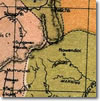Located halfway between Uralla and Bundarra on the western slopes of northern New South Wales, Stony Batter was probably taken up as a pastoral station sometime in 1835. Richard Alexander Wiseman, born in 1806 on the ship Alexander which carried his parents to New South Wales, had been granted land at Wollombi, in the Hunter Valley, in the 1820s. There he built an inn, which he called Young Wiseman’s, and led various expeditions north of Wollombi in search of new land. In the process, he explored a good deal of unknown country and was possibly the first grazier to bring stock to the upper part of the Gwydir Valley. By 1834, Wiseman was grazing cattle on the MacDonald River near the site of present-day Bendemeer. Following the course of the MacDonald, he drove his cattle to Stony Batter, which he claimed, and then moved to Boonal on the Macintyre and a run on the Moonie River even further north.
Stony Batter remained in Wiseman’s hands for a short period; by 1840, when it was visited by the first Commissioner of Crown Lands for New England, GJ Macdonald, the property had been sold to a gentleman named McKenzie. At that time, Stony Batter employed a superintendant and fifteen other people. This was more than on neighbouring properties, but Stony Batter was a huge run. Extending from the Gwydir in the north to the headwaters of the Namoi in the south, it covered more than 200,000 acres of land, 138,000 of which was good grazing country.
McKenzie’s stay on the property, like Wiseman’s, was brief, and within months of Macdonald’s visit Stony Batter had been transferred to the estate of the late George Hall. Hall had migrated to New South Wales in 1802 and, from Dartbrook (his property at Scone), established one of the first pastoral empires in the colony. Hall himself died in 1840, and under the terms of his will, his various pastoral stations were managed by the Hall Family Trust. William Smith Hall, one of George’s grandsons, was charged with the responsibility of looking after Stony Batter. Under his stewardship, the property for the most part remained undeveloped. Free selectors moved in during the 1850s and 1860s, and as a result, a small township developed around the head station. This little collection of buildings – comprising an inn, a post office and stores – was named Kingstown.
In the 1870s, Stony Batter again changed hands. The Hall Family Trust put the property up for auction in 1873, and Joseph and Theophilus Cooper, of nearby Toryburn, bought Stony Batter for Joseph’s eldest daughter, Ellen, and her husband, Arthur Evans Hays. They remained on the original station, near Kingstown, while a new cottage was built further north on the banks of the Gwydir River. This work was supervised by Arthur’s brother, Sydney. Bricks were made on the property, the roof was covered with ironbark shingles and the interior woodwork was cedar. As the family grew – Arthur and Ellen eventually had nine children – it was extended. Pleasantly rambling in its design, the homestead when finished was surrounded by luxuriant gardens, a tennis court and even a cricket ground where matches were often played over summer weekends.
During the 1880s, Arthur Hays was busy working on the property. By this time the colony’s free selection laws had reduced Stony Batter to about 53,000 acres, and, after the custom of the times, Hays spent many days fencing the property. He also cleared large portions of land, planted a small vineyard, and built a station store which offered everything from bridles, plough reins, shears, boots and trousers to cups and saucers, canary seed, pills and even corsets for the ladies.
Having built up a very successful run – by the late-nineteenth century, Stony Batter carried well over 20,000 sheep and about a thousand head of cattle – Arthur Hays died in 1905. A large part of the estate was distributed amongst his sons, and Reg, the eldest of them, took over the management of Stony Batter as well as his own share, which he called Dalkeith. Reg married May Morse and they built a comfortable brick house on Dalkeith, but when May died in childbirth Reg walked off the place for good. In 1911, Dalkeith was sold to FG Taylor of Terrible Vale. In the meantime, Walter Hays, whose share of the property was Fairfield, assumed control of Stony Batter. When Walter was killed by a massive boulder while burrowing for rabbits in 1924, his two eldest sons, Alan and Keith, took charge of the property. Despite early financial difficulties, they made a good fist of and in time Fairfield become a successful property in its own right.
Throughout these years, Stony Batter itself remained in the hands of the Hays Estate and its management was shared between Arthur Hays’ children while their mother continued to live in the old homestead. She died in 1939, and Stony Batter, now only 5,275 acres, was put up for auction but did not sell. Jack and Bill Hays, trading under the name Hays Brothers, eventually gained sole control over Stony Batter (which they divided). Bill, who never married, passed the homestead and 2,200 acres to Walter Hays’ daughter, Kath Cooper, who lived there for many years. Stony Batter remains in the hands of the Cooper family.Related Bodies:
Related People:
References:
Claire Schofield, Bundarra: Stepping Stone of the Gwydir (Inverell: Regional Printers, 1979); Anne Harris, Old Stations of the Gwydir (Neutral Bay: Privately Published, 2000).
|

